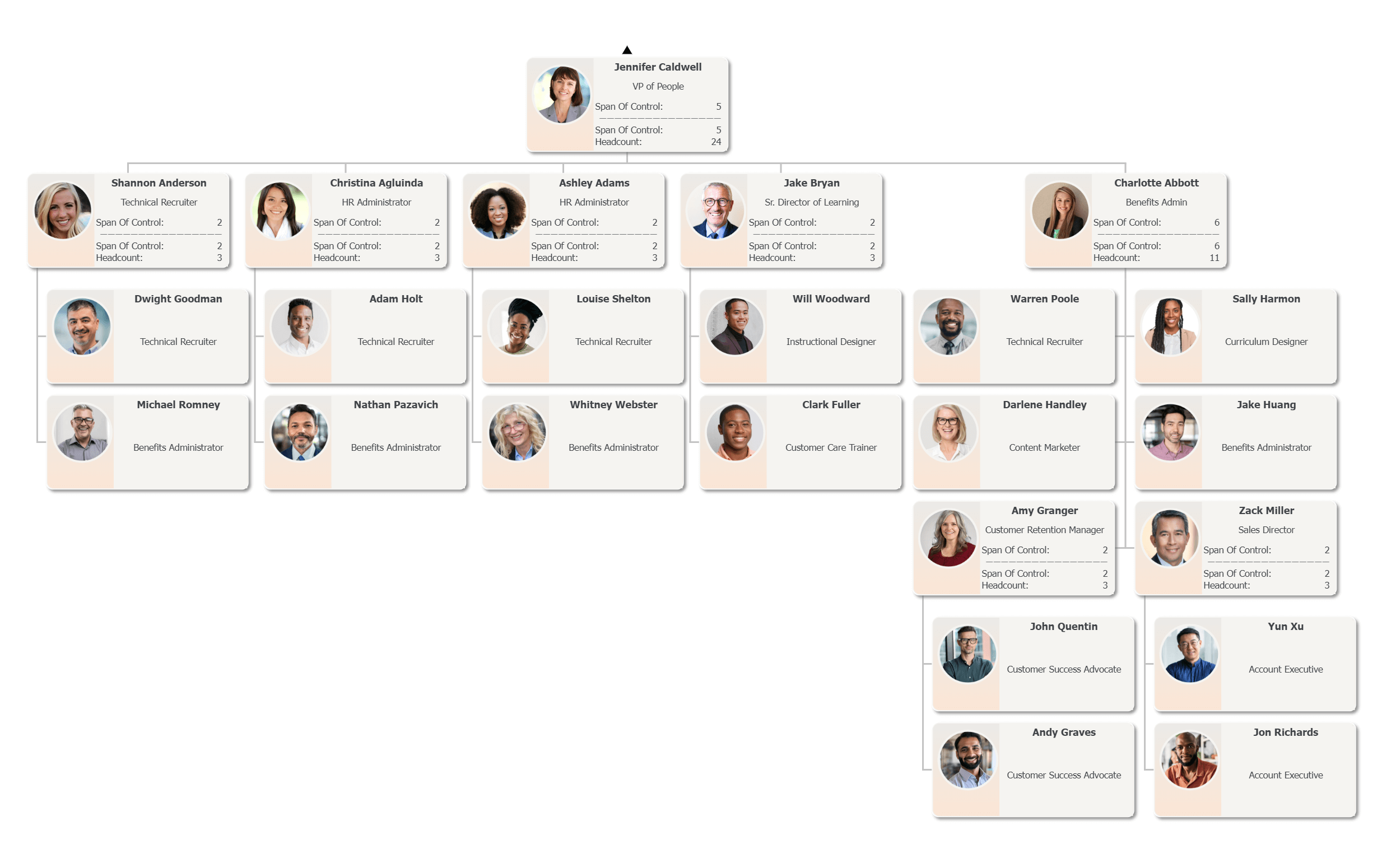
Kimberlee Henry
June 14, 2024
An organization’s span of control can have a significant impact on success. With the proper span of control, your organization is best utilizing its people and resources – all while reducing…

An organization’s span of control can have a significant impact on success. With the proper span of control, your organization is best utilizing its people and resources – all while reducing inefficiency, burnout, and/or overwhelm.
To help you achieve an ideal number of direct reports per manager, we’ve put together this comprehensive guide. You’ll learn how to calculate span of control ratio, how to analyze its effectiveness, and how to apply the best practices.
We’ll cover span of control calculations and discuss several influencing factors to consider.
What exactly is span of control?
Span of control (AKA “span of management”) is the number of direct reports that a manager oversees. Don’t confuse this with “depth of control,” which relates to the number of indirect reports.
The span of control calculation is a ratio of how many direct reports fall under an individual manager.
Many organizations analyze span of control calculations to improve efficiency, performance, communication, and morale.
Calculating span of control can help leadership understand where they are underutilizing and overutilizing their managers.
This can lead to better decisions about hiring, organizational restructuring, resource allocation, and financial waste. For example:
| When a manager has TOO MANY direct reports… | When a manager has TOO FEW direct reports… |
| It becomes difficult to manage a large number of people. Managers may feel burned out, overwhelmed, and overutilized. Plus, they can’t adequately mentor each team member. Subordinates may lack connection with their manager, which may reduce overall engagement and effectiveness of the team. | The business may be underutilizing their managers, wasting resources like time and money. Plus, managers may turn to micromanaging their small group, which can be frustrating for subordinates. |
The goal is to achieve an “ideal span of control ratio.” This is unique to the needs, skill sets, and specifics of your organization. Here is a step-by-step guide to help you:
Whenever possible, use data to inform your span of control calculations.
Collect internal information pertaining to the number of managers and subordinates you currently have and how the teams are structured.
Use your existing org chart as a starting point. If you currently don’t have an easy-to-modify, drag-and-drop chart, see what OrgChart software can do.
Since the ideal span of control differs by each organization, it’s best to analyze what similar businesses are doing within your industry.
For example: Optimal span of control for a small business in wildlife management is 1:5 to 1:10. (Wildlife Management Institute)
Another example: Optimal span of control for managers in a clinical setting is 1:6 to 1:10. And this can differ based on the level of leadership. (SullivanCotter)
Consider the size of your organization and how it may impact the span of control ratio.
Larger organizations tend to have more complex structures and hierarchies, which may require a narrower span of control (more vertical tiers).
Smaller organizations may require fewer layers of management and can afford to have a flatter, wider span of control.
If subordinate tasks and responsibilities are relatively simple and straightforward, a manager may be able to supervise a large number of employees.
However, if tasks are complex and/or require a high level of expertise or decision-making, a smaller span of control may be necessary to ensure proper guidance, mentorship, and support.
Self-directed employees who have a high level of autonomy may not need as much managerial oversight, allowing managers to handle a larger number of subordinates.
However, for those who need hands-on guidance and close supervision, a manager may need a smaller span of control. This allows a manager to provide the appropriate level of support.
Once you’ve assessed all the relevant factors, you can calculate your span of control ratio.
This is usually expressed as something like 1:5 or 1:20. The first number pertains to the number of managers. The second number pertains to the number of subordinates.

To help you, here is the span of control formula.
While you can do this manually, certain tools and software can automate the process and even integrate with your current HR tools and org chart.
| Span of Control Formula Number of subordinates / Number of managers = Span of control ratio |
Let’s look at a few examples.
| Span of control calculation | |
| Business A is a large business with 24 managers and 1200 subordinates that report to them. 1200 subordinates / 24 managers = 50 | 1:50 *Each manager oversees 50 employees. |
| Business B is a very small health clinic where the owner (who is a doctor) manages the secretary, the nurse, and the lab assistant. 3 subordinates / 1 owner = 3 | 1:3 *The owner oversees 3 people. |
It’s important to determine if the “ideal” ratio is feasible for your organization. Here are things to consider when making this decision:
| Span of control is too narrow | Span of control is too wide | |
| Employee satisfaction | Employees may feel micromanaged and that they lack the autonomy they deserve. | Employees may have a disconnect with their manager and fail to receive adequate support. |
| Communication | Communication may be slow, since several layers of management need to approve decisions. | Managers may struggle to stay informed about every subordinate, leading to misinformed decisions. |
| Managerial workload | Managers may be micromanaging or overmanaging employees, which is poor utilization of the manager’s time. | Managers may feel overwhelmed and cannot provide adequate support to everyone. |
Organizational performance and productivity can also be affected by span of control.
Depending on how you modify your span of control calculations, communication, managerial effectiveness, and employee engagement can have a positive or negative impact.
Determining the optimal span of control for your organization requires a thoughtful and data-driven approach.
While there is no one-size-fits-all solution, there are several key factors to consider:
| Notes | How to achieve your ideal span of control | |
| Industry norms | These give you a baseline to compare your organization against and help you understand the ratios commonly used in your industry. | Consider factors such as complexity of tasks, level of employee autonomy, and the size of your organization when comparing against industry benchmarks. |
| Organizational size and complexity | Larger organizations have the ability to establish several tiers of leadership, which can help alleviate the responsibilities of each manager. Small organizations often have to widen their span of control. | Consider the impact on communication, workload, and the manager/employee relationship. |
| Financial constraints | Some businesses may not have the financial means to hire multiple managers, which puts pressure on the existing ones. | Consider how adding more managers could improve performance, efficiency, and profitability of the organization. Think about potential ROI. |
| Managerial ability | Experienced managers and those with great people skills may be able to oversee a large number of people. Less experienced managers may benefit from a smaller span of control. | Consider the personality types and leadership styles of your managers. Collaborative leaders may be best suited with a narrower span of control, whereas more authoritative leaders may be able to manage a very large team. |
| Employee ability | Skilled employees generally need less oversight, so they could be working under a wide span of control. Novice employees can benefit from close training and mentorship. | Consider redefining your span of control to accommodate employees with varying levels of expertise. This is a human-centric approach to span of control calculations. |
| Task complexity | Very complex and difficult tasks may need more oversight (even when completed by skilled professionals). Easier tasks usually require less oversight. | Consider mapping out task complexity to help you make decisions about which managers can afford a larger span of control, and where others need to focus on a small team. |
| Communication | A narrower span of control allows for better communication between a manager and employee. Wide control needs ways to communicate effectively. | Consider the strengths and weaknesses of your current organizational communication, and use that to inform your next steps. |
| Employee satisfaction | A narrow span of control can lead to inappropriate micromanagement. However, a wider span of control can lead to less engagement and a feeling of disconnect with the manager. | Consider how you can strike a balance between providing enough employee autonomy and connection with the management team. |
Ideal span of control calculation varies greatly based on type of business, industry, and other specifics like type of tasks and/or type of people.
It’s important to look at both your industry and internally.
Identify what is working and what is not working in regard to span of control. From there, you can optimize span of control to address various business challenges, including:
Span of control should be reevaluated periodically, especially when the organization is undergoing significant goal changes, streamlining, and/or hiring.
Even though a span of control calculation may seem like a straightforward value to strive for, there are many nuances to determining the ideal ratio for your organization.
Span of control ratios should be used as a guide since they don’t show you the whole picture.
Span of control ratio is largely based on the people within your organization and how you want to improve in the future. Do you want to promote a better workplace culture? Do you want more appropriate oversight?
Aim to find a balance that empowers employees, promotes engagement, and supports their performance.
And while you can do this manually, it’s certainly difficult to upkeep time after time again. Learn more about how you can use certain tools and software like OrgChart that have integrations directly into your current HR tech stack, to automate this process for you.

Restaurant Hierarchy Chart: Structure & Roles…
Restaurants are arguably the busiest businesses out there, with servers, cooks, managers, and executives working hard to ensure every guest has a stellar…
Read Article
Managing Positions in a Company Chart: Strategies for Modern HR Teams…
As companies grow beyond 100 employees, managing organizational structure becomes exponentially more complex. HR professionals need an advanced, dynamic…
Read Article
Healthcare Organizational Chart: Structure, Examples & How to Build One…
Explore the power of People Analytics. Unlock data-driven HR strategies to optimize your workforce with our tools.…
Read Article